A guide to growing "Russian Bogatyr" tomato in open ground or greenhouse for beginner gardeners
Russian Bogatyr is an incredibly tasty and healthy variety of tomatoes that are so difficult to find on store shelves. They fall in love with him after the first harvest. Novice summer residents like it for its ease of care and cultivation.
Plants present large, fleshy fruits to gardeners. Many positive qualities in one variety are the Russian Bogatyr tomato. We will tell you in detail how to get your harvest of these tomatoes even for a novice summer resident and describe the step-by-step process of growing from seed preparation to harvesting.
The content of the article
Characteristics and description of the variety
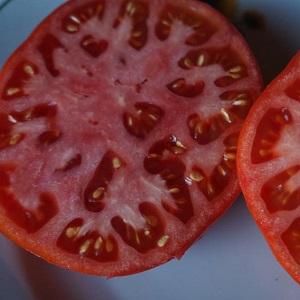 Russian Bogatyr lives up to its name: a huge spreading bush grows up to 2 m in height, bearing 5-6 kg of large fruits. Several brushes are formed on each bush, on which 4-5 tomatoes ripen. By the end of summer, the Russian Bogatyr tomato variety brings summer residents a bountiful and high-quality harvest. Since the bushes of this variety are very spreading, they need to be tied up and pinned.
Russian Bogatyr lives up to its name: a huge spreading bush grows up to 2 m in height, bearing 5-6 kg of large fruits. Several brushes are formed on each bush, on which 4-5 tomatoes ripen. By the end of summer, the Russian Bogatyr tomato variety brings summer residents a bountiful and high-quality harvest. Since the bushes of this variety are very spreading, they need to be tied up and pinned.
The fruits of the Russian Bogatyr are large, fleshy, bright pink or red, contain a minimum of seeds and water. The fruits have a thin but dense skin, which prevents cracking even when cutting.
Among other things, the fruits of the Russian Bogatyr have an unusually pleasant aroma and a delicious sweetish taste, not in the least like the taste of store-bought tomatoes. That is why tomatoes of this variety are so fond of putting on the festive table both fresh and canned. Russian Bogatyr tomatoes are perfect for obtaining tomato juice, which is not made from all varieties.
Russian Bogatyr is a mid-season tomato. Its ripening period varies from 95 to 105 days after germination. Plants bear fruit more than once a summer, but 2 or even 3 - right up to the fall. Considering the weight of each fruit - 350-450 g - you can only imagine how many tomatoes you will collect by the end of summer from just one garden. On the lower hands, the fruits reach a weight of 700 g - you are guaranteed abundance on the table.
The shape of each fruit is slightly flattened, with pronounced ribs at the base. As it ripens, the fruit changes color from green to deep pink and red.
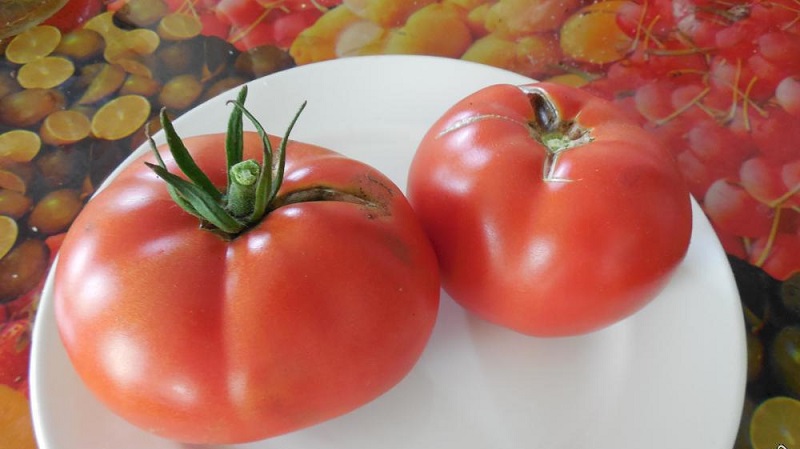
Growing seedlings
The process of growing seedlings has a standard technology. By following our instructions, you can easily germinate seeds and prepare your seedlings for planting at home.
Seed preparation
Seed preparation is a mandatory step when planting any plant.
First, the purchased seeds must be disinfected. Place the seeds in warm water with a pinch of potassium permanganate and let sit for half an hour. Then start germination. Germination begins with laying out rows of seeds on a hard flat surface (tray, baking sheet, box of holes). Cover the seeds with moistened gauze on top. Don't choose another fabric: gauze nourishes the seeds best with moisture and leaves them access to air.
Important! The gauze must always remain damp for the seeds to germinate. When the gauze dries, moisten it with water from a spray bottle to avoid "flooding" the seeds.
To increase germination, use growth stimulants - "Epin", aloe juice with water.
Planting seeds
To plant seeds, you need to prepare a container, for example, a box, and soil.Partially place the soil in a container, previously loosened, and water a little. Then place the sprouted seeds in the soil in rows 1.5 cm apart and about 2 cm deep. Then sprinkle some earth on top and leave in a warm place for a few days. Water the soil a little every day to keep it from drying out.
Important! Cover the box with transparent wrap to create a greenhouse-like environment. This will keep warm and promote the early formation of seedlings.
After germination, keep the box in a warm and constantly lit place. If there is not enough natural light, special fluorescent lamps create such conditions. These lamps are very helpful for gardeners, since when growing seedlings, the light should be not only constant, but also comprehensive. Sunlight, as a rule, provides illumination from only one side of the box, which negatively affects seedlings.
It is also necessary to monitor the temperature in the room: it must be at least +20 degrees for healthy sprouts to appear. After 10 days, when the first sprouts have already appeared, bring this temperature closer to room temperature.
3-4 days after planting, the seeds should germinate, and after 2 weeks turn into seedlings. As soon as the first leaves appear on the seedlings, transplant them into separate containers (for example, plastic or clay cups) so that they do not interfere with each other. The main conditions for the full development of sprouts: regular watering, constant temperature. Then, after about a month and a half, your sprouts will be ready for planting in the ground.
Attention! To harden the plants and prepare them for transplanting into the greenhouse, periodically take the box outside or put it in an open window. Increase the time from a few minutes to 8-10 hours.

Growing tomatoes in a greenhouse
The time for planting sprouts in the ground is approximately in May (if the seeds were harvested in March). It is preferable to plant the sprouts in a greenhouse, even if you plan to transplant them in the open ground in the future. Young shoots are extremely sensitive to temperature extremes.
For proper planting and maintenance of tomatoes, follow the instructions below.
Landing
The earth must necessarily be dug up, formed into beds. Each bed is moistened and mineral or organic (for example, humus) fertilizers are added to the soil. Better to enter them in the form of an aqueous solution.
Carefully move each seedling from the container into the soil and sprinkle it with earth on top so that the roots of the plant are covered by 2 cm from above. Place the seedlings approximately 25 cm apart. So in one square meter 4-5 bushes fit.
Important! Do not plant sprouts close to each other, as the Russian Bogatyr tomato has a spreading bush.
After planting, lightly water the beds again and leave in the greenhouse. In the future, the sprouts will require regular watering, and they need to be fertilized 1-2 times a month.
Care
Caring for tomato bushes includes tying, pinching, watering, weeding, loosening and fertilizing the soil:
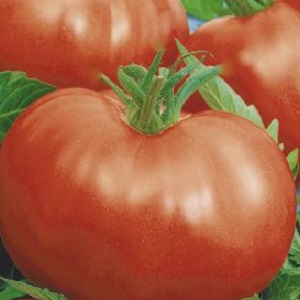 Tying... Russian Bogatyr tomatoes grow large, both in terms of the size of the fruit and the size of the bush itself, so tying is mandatory. This procedure is necessary so that, under the weight of large fruits, the branches of the plant do not break off and do not sink to the soil, as this will damage the fruits. There are 2 types of tying: vertical and horizontal. With the vertical type, the plant is tied to a vertical support (a peg or stick previously driven into the ground). Each branch is attached to a support and left fixed. When tying horizontally, the branches of the plant are attached to a horizontal support (trellis). As a rule, a rope or wire stretched along the greenhouse closer to the top is chosen as such a support. The ropes are tied to this support in the same way, supporting the branches with fruits.For this variety of tomatoes, it doesn't matter which garter you choose: horizontal or vertical.
Tying... Russian Bogatyr tomatoes grow large, both in terms of the size of the fruit and the size of the bush itself, so tying is mandatory. This procedure is necessary so that, under the weight of large fruits, the branches of the plant do not break off and do not sink to the soil, as this will damage the fruits. There are 2 types of tying: vertical and horizontal. With the vertical type, the plant is tied to a vertical support (a peg or stick previously driven into the ground). Each branch is attached to a support and left fixed. When tying horizontally, the branches of the plant are attached to a horizontal support (trellis). As a rule, a rope or wire stretched along the greenhouse closer to the top is chosen as such a support. The ropes are tied to this support in the same way, supporting the branches with fruits.For this variety of tomatoes, it doesn't matter which garter you choose: horizontal or vertical.- Watering... The Russian Bogatyr tomato variety is unpretentious in watering, even in arid regions. If you forgot to water the garden, it doesn't matter: the Russian Bogatyr feels good without moisture for up to 2 weeks. However, it is best to water the tomatoes 2-3 times a week. When watering, make sure that no water drops fall on the plant leaves, so keep the watering can close to the ground. With abundant moisture, a fungal infection or burns caused by exposure to sunlight appears on the leaves.
- Weeding. Russian Bogatyr is not particularly whimsical in weeding, but do not forget that large weeds take nutrients from the plant, so they should be removed in a timely manner. For small weeds, remove them as they grow.
- Loosening the soil. This is done to prevent the soil from hardening and allowing the bush to grow freely, as well as to saturate the plant roots with oxygen. Weed the bed as weeds grow, but be sure to loosen it after each watering. Loosening is done with a hoe or a special garden spatula.
- Fertilizing the soil. Fertilize tomatoes 1-2 times a month. Both mineral and organic fertilizers are used. Fertilizers promote the growth of healthy bushes and a bountiful harvest. Add fertilizer either to the soil itself when loosening or to the water for irrigation.
- Stealing. Not many novice gardeners know about pinching, but in vain: in our case, this is a mandatory procedure for caring for tomato bushes. When pinching, young shoots and non-fruiting branches are removed, which grow strongly. Such shoots take up nutrients, which slows down the growth and development of fruiting branches. A bountiful harvest is obtained from the treated bushes, which look like a stem and several fruiting branches. This procedure greatly simplifies the growth of the plant and the fruit on it and has a positive effect on the taste and quantity of the fruit.
Diseases and pests
An integral part of plant care is pest and disease control. The Russian Bogatyr variety greatly facilitates the life of summer residents, since it is immune to many diseases and is rarely attacked by pests. However, in any case, a good gardener should know the most common diseases of tomatoes and pests, and practice ways to combat them.
The most common tomato disease is late blight. This is a fungal disease that manifests itself in various spots on the leaves. This disease occurs if you water the bush too often and abundantly or get water on the leaves. Therefore, to prevent the disease, it is necessary to observe the watering regime and not flood the beds. If the disease has already manifested itself, then the best fight is to collect the affected leaves so that the disease does not spread from one leaf to another.
Important! Diseased leaves or plants are burned after removal.
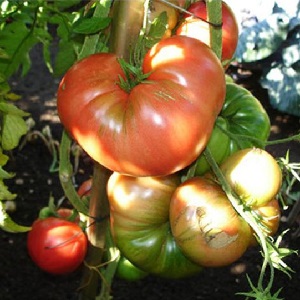 After collecting the affected leaves, treat the plants with a copper solution. This is a preventive measure that helps to avoid spreading the infection further and kills it.
After collecting the affected leaves, treat the plants with a copper solution. This is a preventive measure that helps to avoid spreading the infection further and kills it.
Another disease is mosaic. It is also characterized by the appearance of white-yellow spots on the leaves and stem of the plant. However, infection does not occur through water, but through insects. The most frequent distributor of mosaics is aphids. The diseased areas dry up and fall off over time.
As a prophylaxis and treatment of mosaics, spray the bushes with copper-containing preparations and soap solution (4 tablespoons of liquid soap per 1 liter of water). The affected areas also need to be torn off and burned, without waiting for them to spontaneously fall off.
It is worth remembering about a variety of pests and vectors diseases. In addition to the aphid that spreads the infection, these are Colorado May beetles, whitefly and bear. All these insects harm plants in their own way.The whitefly eats the foliage along with the nutrients required for fruit growth. May beetle lays larvae in the soil, which eat the roots of the plant, because of which it subsequently dies. The same harm is caused by the bear and the Colorado potato beetle.
If pests are found, it is necessary to treat the bushes and soil with soapy water or special insecticide preparations, which are sold in gardening stores.
If you follow all of the above instructions, namely, stabilize the regime of watering, weeding, loosening, tying up bushes, feeding, pinching and preventing and treating diseases, destroying pests, by the middle of summer you are already guaranteed to receive a bountiful harvest of ripe Russian Bogatyr tomatoes.

The nuances of growing outdoors
Russian Bogatyr tomatoes are suitable for growing both in a greenhouse and in the open field. However, the variety is thermophilic and still prefers a greenhouse, in which it gives a more bountiful harvest. Tomatoes are planted in open ground in a warm climate or hot summer. At the same time, make sure that the bed is not excessively flooded with precipitation and gusts of wind do not break the stems of the plant.
Let's list the points that are worth remembering when landing in open ground:
- Moisture. Excessive rainfall on the beds reduces yields, contributes to the development of fungal diseases or even the death of the plant. In addition, infectious agents (such as late blight) are more often found in rainwater.
- Pests. Pests are much more likely to attack plants planted in open areas than those growing in a greenhouse. It is easier for insects to lay the larvae in the open field and it is easier for insects to easily reach the foliage of tomatoes.
- Temperature. Due to a special love for warmth, the Russian Bogatyr tomato bears less fruit in the open field. When planting in an open bed, cover it with plastic wrap overnight, but this is not always enough. It is necessary to monitor the temperature regime, prevent hypothermia of the plant and tie it tightly to avoid breaking the stem and branches. Moreover, in the open field, the Russian Bogatyr will begin to bear fruit later.
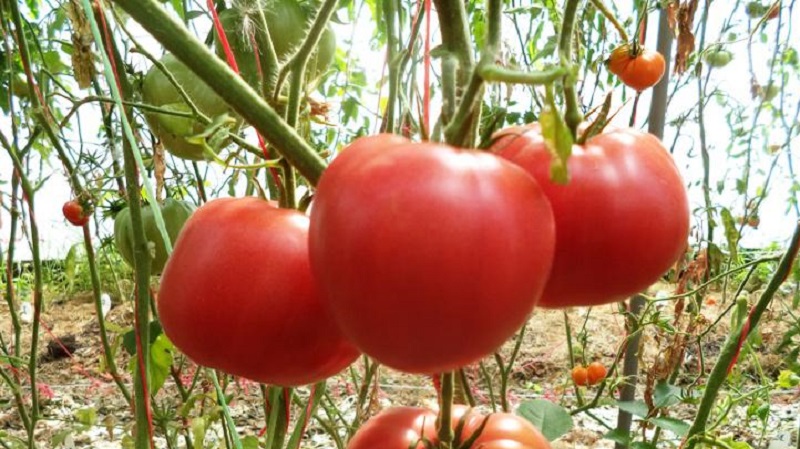
Harvesting and application of the crop
When a Russian bogatyr tomato turns bright pink or red, this indicates the ripeness of the fruit. This usually happens by the end of July, but can continue until the end of September.
Picking tomatoes is the easiest and most enjoyable part of the growing process, but there is a certain technology in this business. In order for the fruits to retain their shape and beautiful appearance, carefully remove them from the branch without damaging the branch itself and the skin of the fruit. Hold the fruit with one hand, the branch with an arc and slowly pull it towards you. If the tomato is really ripe, it will be in your hand without much effort.
Place tomatoes in a container (for example, a box), which should be covered with paper, in rows to avoid bruising. Do not put more than 2 layers of tomatoes in one box - this will keep them denser and keep their integrity.
Next, place the boxes in a dry place, protected from direct sunlight. Prevent fruit from rotting. To prevent the putrefactive process from starting on the tomatoes, store them at a temperature of + 14-17 degrees and do not allow moisture to get on them.
If you want to transport the fruit over long distances, pick it a little unripe. This will help bring the fruits to the right place just in time for their ripening. Slightly greenish tomatoes tend to ripen already in boxes.
The use of tomatoes is extensive: tomatoes will pleasantly surprise you and your guests with their taste both fresh and cooked or pickled. Russian Bogatyr is perfect for tomato paste and tomato juice.
Everyone's favorite Russian dish - homemade borscht - will sparkle with new colors and flavors if you add slices of stewed tomato to the broth.
Do not forget about the beneficial elements found in tomatoes and their positive impact on health and well-being. Tomatoes strengthen the immune and cardiovascular system, have a beneficial effect on blood vessels and prevent the development of many diseases. Tomatoes have also been shown to improve well-being and mood due to the serotonin they contain. It is also a powerful antioxidant.
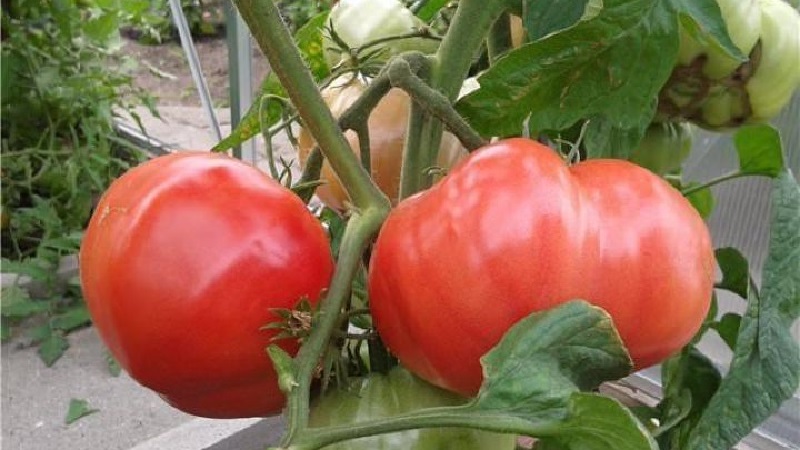
Advantages and disadvantages of the variety
The main advantages of the variety:
- large, fleshy fruits with few seeds;
- bountiful harvest;
- resistance to diseases and pests;
- ease of care;
- the duration of fruiting.
Among the shortcomings, we note:
- thermophilicity (preferably grown in a greenhouse);
- the need for tying and pinching.

What farmers say
A large number of reviews, as a rule, speaks of the outstanding qualities of a particular tomato variety. Russian Bogatyr fell in love with modern gardeners, therefore it has many positive reviews. Here are some of them:
Sergei Ivanov, Leningrad region: “The Russian Bogatyr is really a hero! Just look at the photo! I have never grown such large fruits myself! And most importantly, I did it without much effort. "
Maria Onopchenko, Volkhov: “Excellent tomatoes, very easy to grow, I declare to you as a budding gardener. There were no problems with disembarkation or leaving. "
Anna Moiseeva, Moscow: “For fun, I planted a couple of bushes at my dacha. And they have grown! And they bore fruit! Did not expect. I began to raise them every year. Now there are always fresh tomatoes on the table. "
Galina Ladyzhnikova, Veliky Novgorod: “The Russian Bogatyr is a cook's dream. These large tomatoes bring all your culinary ideas to life. And the tomato paste made from them is simply excellent! "
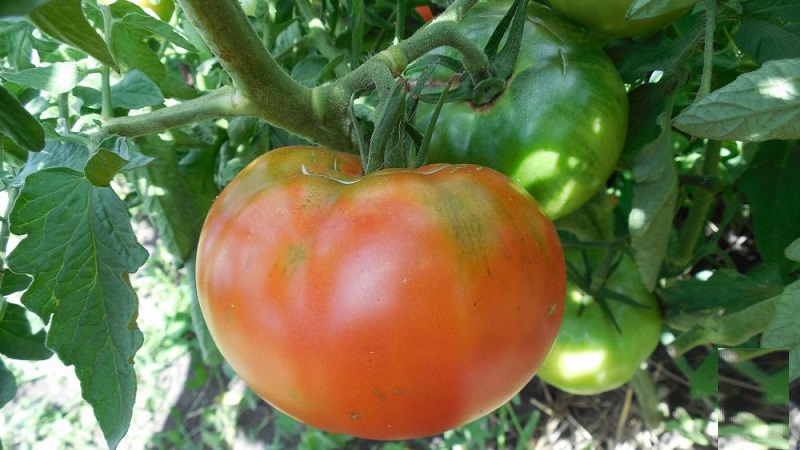
Conclusion
Russian Bogatyr is a truly unique tomato variety. It not only has incredible yields, but is also easy to care for. This is the case when quality and quantity are combined in one.
We strongly recommend that all gardeners try to plant the Russian Bogatyr variety on their site. After that, you will never give up on it!